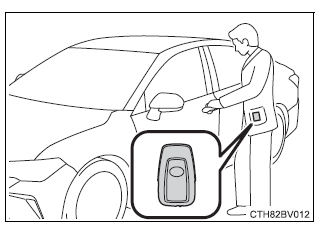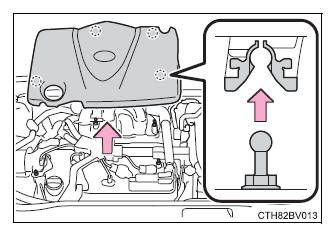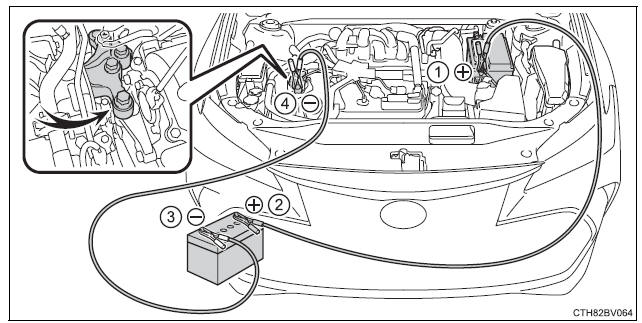You can also call your Toyota dealer or a qualified repair shop.
If you have a set of jumper (or booster) cables and a second vehicle with a 12-volt battery, you can jump start your vehicle by following the steps below.
1. Confirm that the electronic key is being carried.
When connecting the jumper (or booster) cables, depending on the situation, the alarm may activate and doors locked.

2. Open the hood.
3. Remove the engine cover.
Make sure to pull the engine cover straight up when removing it.

4. Connect the jumper cables according to the following procedure:

5. Start the engine of the second vehicle. Increase the engine speed slightly and maintain at that level for approximately 5 minutes to recharge the battery of your vehicle.
6. Open and close any of the doors of your vehicle with the engine switch off.
7. Maintain the engine speed of the second vehicle and turn the engine switch to IGNITION ON mode, then start the vehicle's engine.
8. Once the vehicle's engine has started, remove the jumper cables in the exact reverse order from which they were connected.
Once the engine starts, have the vehicle inspected at your Toyota dealer as soon as possible.
â– Starting the engine when the battery is discharged The engine cannot be started by push-starting.
â– To prevent battery discharge
â– When the battery is removed or discharged
â– When removing the battery terminals When the battery terminals are removed, the information stored in the ECU is cleared. Before removing the battery terminals, contact your Toyota dealer.
â– Charging the battery The electricity stored in the battery will discharge gradually even when the vehicle is not in use, due to natural discharge and the draining effects of certain electrical appliances. If the vehicle is left for a long time, the battery may discharge, and the engine may be unable to start. (The battery recharges automatically during driving.)
â– When recharging or replacing the battery
If you are unsure what mode the engine switch was in before the battery discharged, be especially careful when reconnecting the battery.
â– When replacing the battery
| WARNING â– When removing the battery terminals Always remove the negative (-) terminal first. If the positive (+) terminal contacts any metal in the surrounding area when the positive (+) terminal is removed, a spark may occur, leading to a fire in addition to electrical shocks and death or serious injury. â– Avoiding battery fires or explosions Observe the following precautions to prevent accidentally igniting the flammable gas that may be emitted from the battery:
â– Battery precautions The battery contains poisonous and corrosive acidic electrolyte, while related parts contain lead and lead compounds. Observe the following precautions when handling the battery:
|
| NOTICE â– When handling jumper cables When connecting the jumper cables, ensure that they do not become entangled in the cooling fan or engine drive belt. |
Toyota Avalon (XX50) 2019-2022 Service & Repair Manual > Audio / Video: Front Door Speaker
Components COMPONENTS ILLUSTRATION *A for Driver Side *B for Front Passenger Side *1 COURTESY LIGHT ASSEMBLY *2 FRONT DOOR ARMREST COVER SUB-ASSEMBLY *3 FRONT DOOR TRIM BOARD SUB-ASSEMBLY *4 FRONT DOOR TRIM POCKET COVER *5 FRONT NO. 1 SPEAKER ASSEMBLY *6 MULTIPLEX NETWORK MASTER SWITCH ASSEMBLY WITH ...